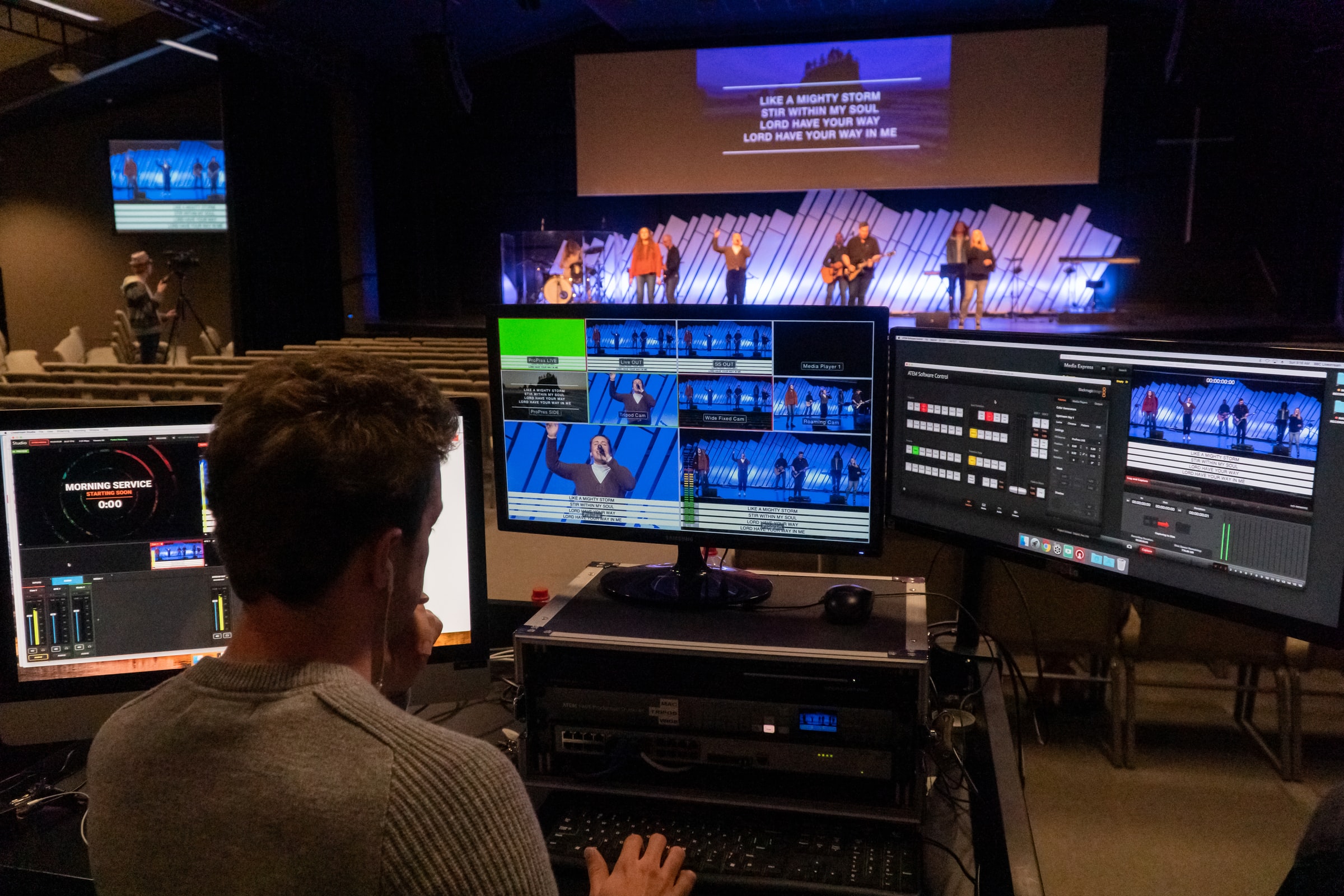
Therefore, one built-in camera in a laptop and the presentation itself does not surprise anyone. People resort to using multiple cameras with high quality optics, zoom capabilities, different shooting angles, external microphones, and so on. More sources of audio and video signals, plus additional requirements for video processing, lighting, signal mixing, as well as online streaming directly to the network, simply force companies to offer the market ready-made all-in-one devices - streaming video switches.
The popularity of web conferencing and signal switching directions
Streaming or "live" video is always more interesting than recording. Everything is real here, there is a presenter, there are viewers and broadcasts in this format are literally tete-a-tete, practical live communication is achieved, up to the voiced questions from the participants and the same answers from the presenters. Accordingly, to create pleasing to the eye and hearing video content, the level of the camera and sound is required slightly higher than from the usual "standard" built-in devices.
Well, if the camera can output a signal via USB, then video capture cards are not required, but if you use several cameras, there will be difficulties. The same story with sound - a separate lavalier microphone, which means there will be an audio cable on the receiving side. It is possible directly to the computer if there is a microphone input. And if there are several microphones, then an additional mixer.
As a result, the paths diverge into either hardware or software signal processing. Mixing on hardware devices will be faster and less likely to fail. Software, respectively, is possible in some cases, with the right approach and skills, more functional, but with its own characteristics.

Hardware devices
The first question that comes up in my head is: "who often works with a" live "signal, if not people from broadcasting?" On the other hand, companies that develop AV equipment for the efficient exchange of high quality audio and video information in various projects also have high-quality video signal switches in their arsenal. But here the focus is on quality, transmission range and signal switching, rather than spectacular transitions.
An additional strong push from the situation around the world since the beginning of 2020 has allowed companies to restructure the approach of their equipment to meet new needs. Thus, a new market segment has appeared, which has combined the functionality of working with "live" video, working with digital signals, at the same time integrating audio and video mixing, packing all this in one device, embellishing the possibility of streaming, which has become familiar to most companies today. day.
Nobody argues that there were video mixers before, but we are talking about mixers with a bias towards household, if I may say so, signals. So even with the addition of streaming features.
That is, a device that can be dealt with not only by a professional, but also by any user. As a result, there are more than ten different compact mixing and streaming devices on the market today, packaged in a single body, from reputable AV equipment manufacturers. There are decent models suitable for studio events, as well as mid-range and basic models that can be used in the office during webinars, at home, or to take with you for outdoor events.
This article will focus only on mixers with integrated streaming functionality, because delving into the separate world of video signal mixers without built-in streaming functionality does not make sense, since the range in this case is different and huge. We are interested in devices of compact size, with basic HDMI inputs / outputs (most commonly used in the masses), with audio signal mixing (including microphones), with connecting microphones, streaming to a network or USB, as well as the ability to conduct web conferences without a professional director's office. preparation.
Streaming Video Switches
The first company, which will be discussed, originates in the land of the rising sun - Japan, in 1972. The main direction is the production of electronic musical instruments and software for them. The company's rich history, having established itself among the music industry, has expanded its sphere of influence in the field of video signals since the 2010s, the result of which is precisely compact streaming switchers.
Roland Corporation offers a wide range of video mixing equipment that keeps pace with the times, maintaining 4K quality standards, but only three models act as streaming mixers at the end of 2020.
 |
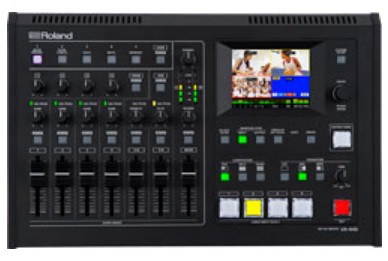 |
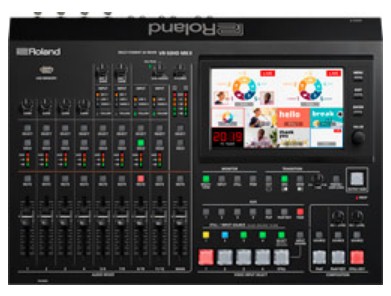 |
|
|---|---|---|---|
| Model | VR-1HD | VR-4HD | VR-50HD MK II |
| Short description | A "plug and play" broadcast studio. | A complete HD studio in a compact format. | , . |
| 3 HDMI | 4 HDMI | 4 HDMI, 4 SDI | |
| MAIN: 1 HDMI;
MONITOR: 1 HDMI; THRU connector: 1 HDMI (from HDMI 3rd); USB: 1x USB (type B); |
MAIN: 1x HDMI or
RGB/COMPONENT; PREVIEW: 1x HDMI; USB: 1x USB (type B); |
2x SDI (PGM OUT, AUX OUT);
3x HDMI OUT (PGM OUT, AUX OUT, MULTI-VIEW OUT); 2x Analog RGB/HD-Component (PGM OUT, AUX OUT); USB: 1x USB (type B); |
|
| 2 XLR/TRS | 4 - XLR/TRS | 6 - XLR/TRS | |
| 1 RCA | 1 RCA + 1 | 2 1/4" + 2 RCA | |
| USB 3.0 , - | USB 3.0 , - | USB 3.0 , - | |
| ( 2020 ) | 105'500 | 224'800 | 528'900 |

It is possible to use the remote control in the video software on the computer (supports Mac and Windows), which completely repeats the functionality of the mixer itself. This function becomes convenient when the mixer is installed directly in the studio and controlled from an operator room or remote room, usually with good sound insulation.

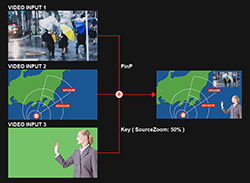 Video switchers support chroma key functions, and already in the younger version of the device it is possible to combine three sources into a single video stream, without the need for additional equipment.
Video switchers support chroma key functions, and already in the younger version of the device it is possible to combine three sources into a single video stream, without the need for additional equipment.
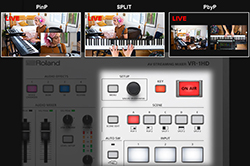 Further, starting with the basic model, there is the possibility of creating ready-made presets, calling which during the broadcast or adjusting on the go, you can combine "picture in picture", apply a combination or split screen (split screen).
Further, starting with the basic model, there is the possibility of creating ready-made presets, calling which during the broadcast or adjusting on the go, you can combine "picture in picture", apply a combination or split screen (split screen).
It is possible to "tie" the microphone input to the input video source, thus facilitating the automatic switching of video cameras, depending on the speaker. There is a function of changing the voice of speakers - where any participant can speak with the voices of other people or not at all, creating various effects during the presentation.
And the most important thing here is the built-in ability to connect and broadcast audio-video signals via USB 3.0 to a computer, and then to any platforms. At the same time, in addition to extracting the embedded (embedded) audio signal from HDMI video sources, you can mix the audio signal from the USB port during calls over software video conferencing (Skype, Zoom, Teams, and so on). The developers did not forget to integrate Echo Cancelation to prevent feedback from computer audio.

In the older VR-4HD model, the visible difference is the built-in touch screen, on which you can display multiview mode, as well as control menu information.
There is support for the DSK (Downstream Key) function - for superimposing titles, lyrics or logos on video signals of sources that can change.
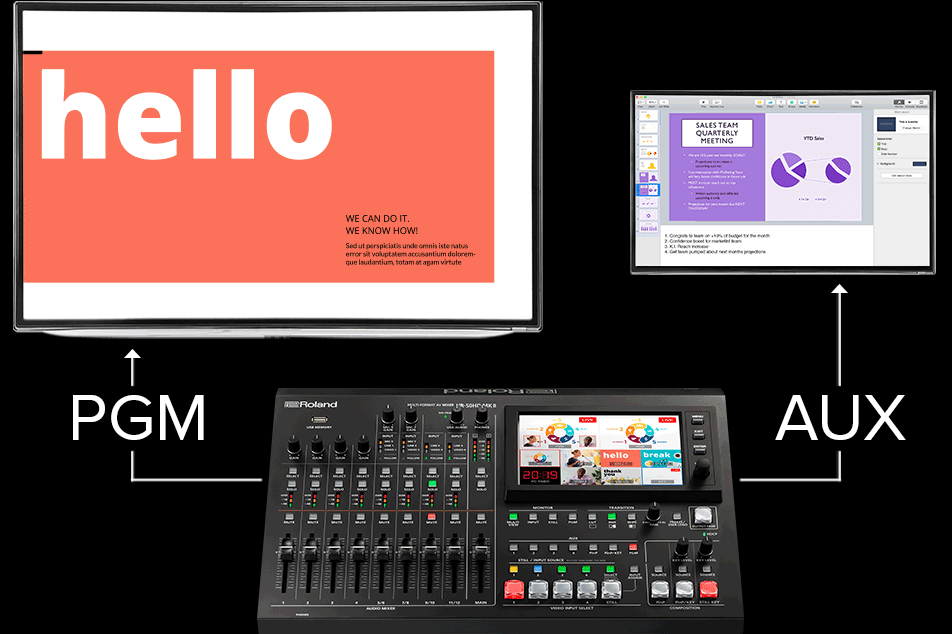 And the expanded VR-50HD MK II already has remote control of connected PTZ cameras, allowing up to six PTZ cameras to be controlled simultaneously over the network. There are three output interfaces - Program, Multiview, and AUX, allowing you to redirect any connected signal to this output, which works independently of the main program output.
And the expanded VR-50HD MK II already has remote control of connected PTZ cameras, allowing up to six PTZ cameras to be controlled simultaneously over the network. There are three output interfaces - Program, Multiview, and AUX, allowing you to redirect any connected signal to this output, which works independently of the main program output.
As a result, we get a compact device that, on the one hand, allows switching video sources, and on the other hand, provides simple control of audio signals. Moreover, all controls are designed for one operator, without requiring specialized knowledge.
Another company, which was only founded in 2002 and is an Australian manufacturer of electronic equipment primarily designed for broadcast and video production, quickly became popular in the broadcast television industry. And already in 2020, it introduced a line of compact video switchers with the ability to stream broadcasting that meet today's trends in the AV market.
Blackmagic offers three switcher options for creating multi-camera broadcast content.

The entire line of mixers is devoid of surplus, compact design, minimal dimensions, only what is needed is taken into account here. It seems that this device was developed specifically as an add-on for webcasts and nothing more.
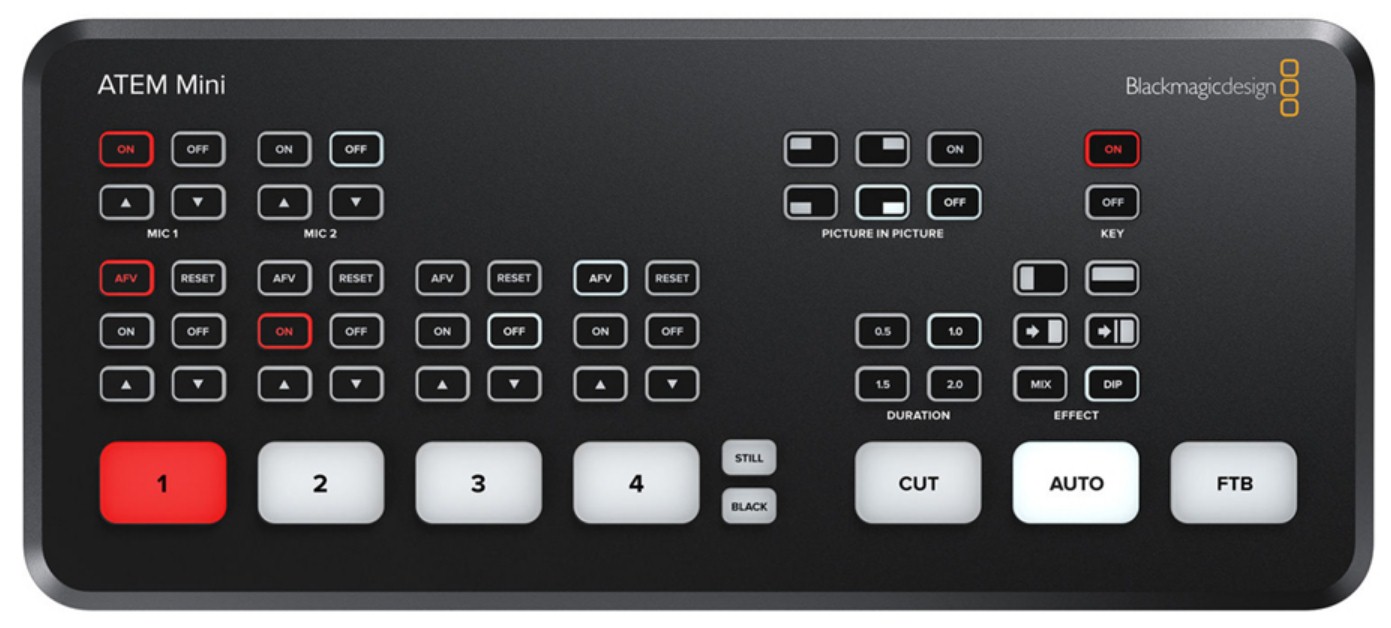 |
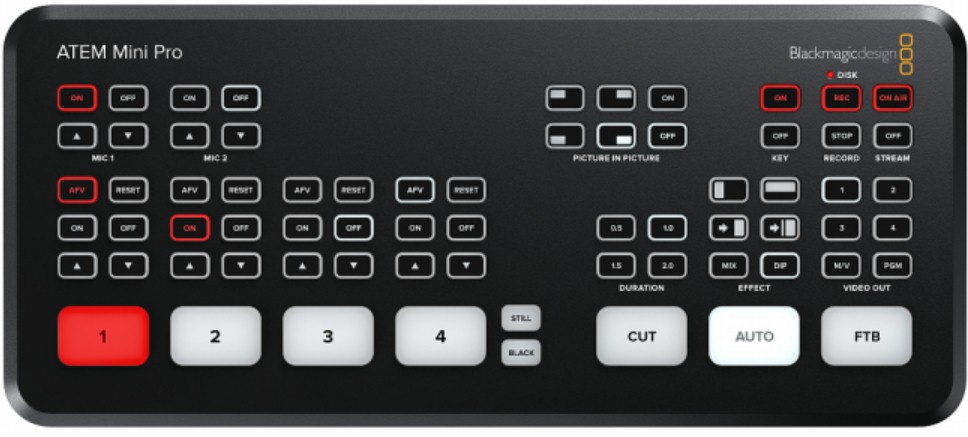 |
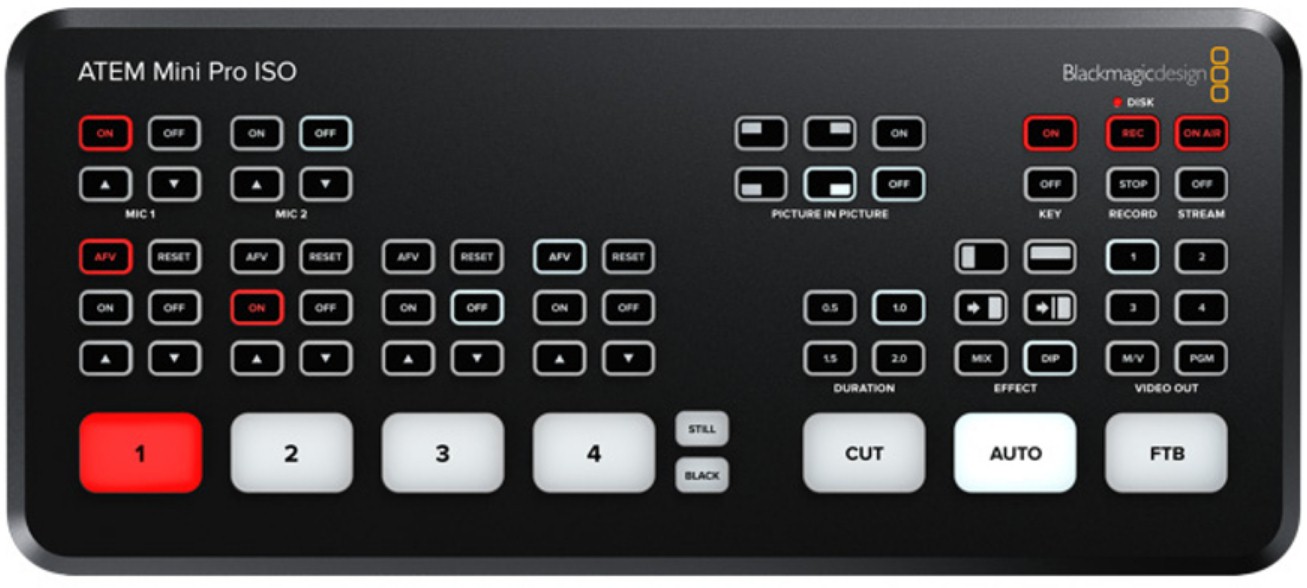 |
|
|---|---|---|---|
| Model | ATEM Mini | ATEM Mini Pro | ATEM Mini Pro ISO |
| Short description | 4HDMI , 1HDMI 1USB, 2 . | mini, Pro H.264 - USB, Ethernet. ( 4 ). | Pro, ISO 5 H.264. DaVinci Resolve . |
| 4 HDMI | 4 HDMI | 4 HDMI | |
| 1HDMI
1xUSB |
1HDMI
1xUSB |
1HDMI
1xUSB |
|
| Up to 1080p60 | Up to 1080p60 | Up to 1080p60 | |
| *support input standards up to 1080i/p60
** HDMI |
|||
| 2 (mic) 3.5mm miniJack (stereo) | 2 (mic) 3.5mm miniJack (stereo) | 2 (mic) 3.5mm miniJack (stereo) | |
| Multiview | - | + | + |
| Ethernet | Ethernet | ||
| USB- | - | + | + |
| ( 2020 ) | 34'790 | 59'900 | 91'990 |
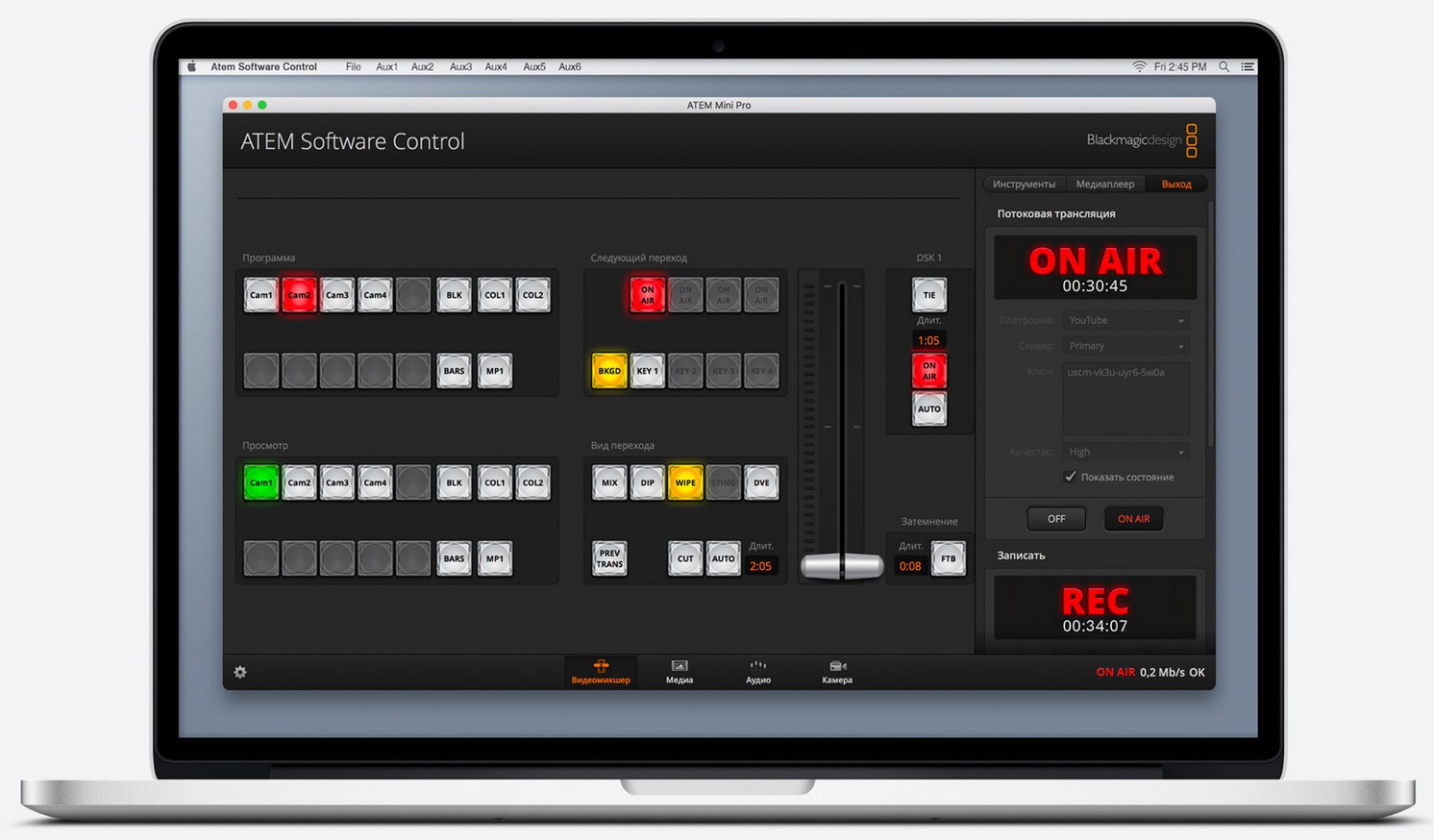 All compact mixers of this manufacturer support effective transitions, the ability to overlay titles, free ATEM Software Control software for remote control from a computer, plus you can develop your own products using the SDK.
All compact mixers of this manufacturer support effective transitions, the ability to overlay titles, free ATEM Software Control software for remote control from a computer, plus you can develop your own products using the SDK.
The only differences are in streaming and recording signals for post-processing.
The basic model mini is a mini-mixer with the ability to effectively switch 4 input signals and output any of them via the HMDI interface. If streaming is required, then you need a USB connection to a computer with installed software (free from the manufacturer). And the Ethernet port in this model is used only for remote control.
 The mid-range Pro has all the features of the basic version, but it already has the ability to stream directly to H.264 over the Ethernet port. The HDMI port in this case is used for multiview mode, on which you can display: preview signals, program, each input signal, media player with selected graphics, recording, broadcast and audio block status.
The mid-range Pro has all the features of the basic version, but it already has the ability to stream directly to H.264 over the Ethernet port. The HDMI port in this case is used for multiview mode, on which you can display: preview signals, program, each input signal, media player with selected graphics, recording, broadcast and audio block status.
, , ( ), wi-fi.
 And the expanded Pro ISO model allows you to record five signals - program and clean signals from the inputs for further editing.
And the expanded Pro ISO model allows you to record five signals - program and clean signals from the inputs for further editing.
As a result, the company presents three options, from the simplest one, where an additional PC is required for broadcasting, the middle version - which already has full functionality for mixing channels, recording to external disks and, most importantly, broadcasting. And the top option is for those who need more post-processing in addition to the main functionality.
 Another company, founded in 1979 in Taiwan, with the motto "just the best connections" is marketed as a manufacturer of switching equipment. In addition to the existing hardware, it introduced an amazingly compact switcher to keep up with the trends in streaming content in the market.
Another company, founded in 1979 in Taiwan, with the motto "just the best connections" is marketed as a manufacturer of switching equipment. In addition to the existing hardware, it introduced an amazingly compact switcher to keep up with the trends in streaming content in the market.
The ATEN UC9020 is a mixer that does not have a built-in display. Therefore, in order to view additional information (and it is needed), you will have to purchase a tablet from the equally well-known American company Apple. And so that the tablet does not run out of power at an inconvenient moment of time, you will need another splitter for power.
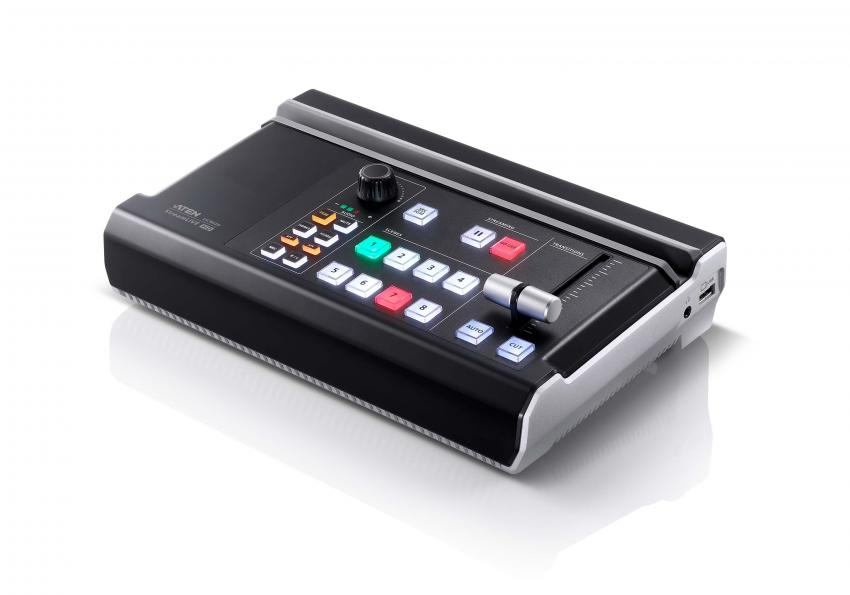 |
|
|---|---|
| Model | U9020, U-9020 |
| Short description | Portable multi-channel video and audio mixing device with streaming capability. |
| Video inputs | 1x HDMI (up to 4K @ 60Hz);
2x HDMI (up to 1080 @ 60Hz, switchable) |
| Video outputs | 1x Loop-Thru HDMI (up to 4K @ 60Hz);
1 x HDMI (PGM) (up to 1080 @ 60Hz); USB 3.0 |
| HDCP | Not supported |
| Audio inputs | De-embedding from HDMI;
1x mic input, 6.5 mm (dual mono); 1x line-in, RCA |
| Audio outputs | HDMI;
1x , 3,5 () |
| USB- | USB- |
| ( 2020 ) | 136'030 |
The ideology of the device is that software, like a PC, is not required, it implies work in plug-n-roll format. The built-in functionality allows you to preview and monitor through the application on the tablet, change presets with a choice: full screen mode, image side by side, picture in picture, allows you to overlay text and subtitles. The broadcast itself goes directly through the Ethernet port, which is convenient.
The result is a very compact device, where an additionally purchased tablet is a feature immediately, if there is none. This video mixer allows you to capture sound directly from only one microphone, which means that with this set of characteristics, the device is more suitable for broadcasting with one participant than for holding any kind of discussions and discussions. Founded in 1985,
another Taiwanese manufacturer, DataVideo , mainly focusing on the design and manufacture of equipment for the broadcast market, has also released a streaming mixing console with a main 14 ”touchscreen and additional controls.
 |
|
|---|---|
| Model | KMU-200 |
| Short description | « », , , . |
| 1x HDMI 2.0 (up to 3840x2160p@60);
1x HDMI 1.4 with Loop through (up to 1920x1080p@60) |
|
| 2x HDMI 1.4 (PGM, AUX) (up to 1920x1080p/i@60) | |
| HDCP | |
| 2x XLR(Mic);
2x RCA |
|
| 2x Unbalanced RCA | |
| SD- | |
| ( 2020 ) | 359'325 |
 So, the ideology of the device allows you to capture a video signal from two physical interfaces, one of which supports 4K resolutions, and the other (with additional pass-through output) only fullHD resolutions. At the same time, the essence of support for cameras with a 4K resolution is that you can make 4 cuts of frames from one stream, thereby obtaining 4 different pictures (as if you have 4 input video streams).
So, the ideology of the device allows you to capture a video signal from two physical interfaces, one of which supports 4K resolutions, and the other (with additional pass-through output) only fullHD resolutions. At the same time, the essence of support for cameras with a 4K resolution is that you can make 4 cuts of frames from one stream, thereby obtaining 4 different pictures (as if you have 4 input video streams).
Plus, there is a general view and the ability to add a pre-prepared picture. A total of six tracks of video content and six physical keys for switching these sources.
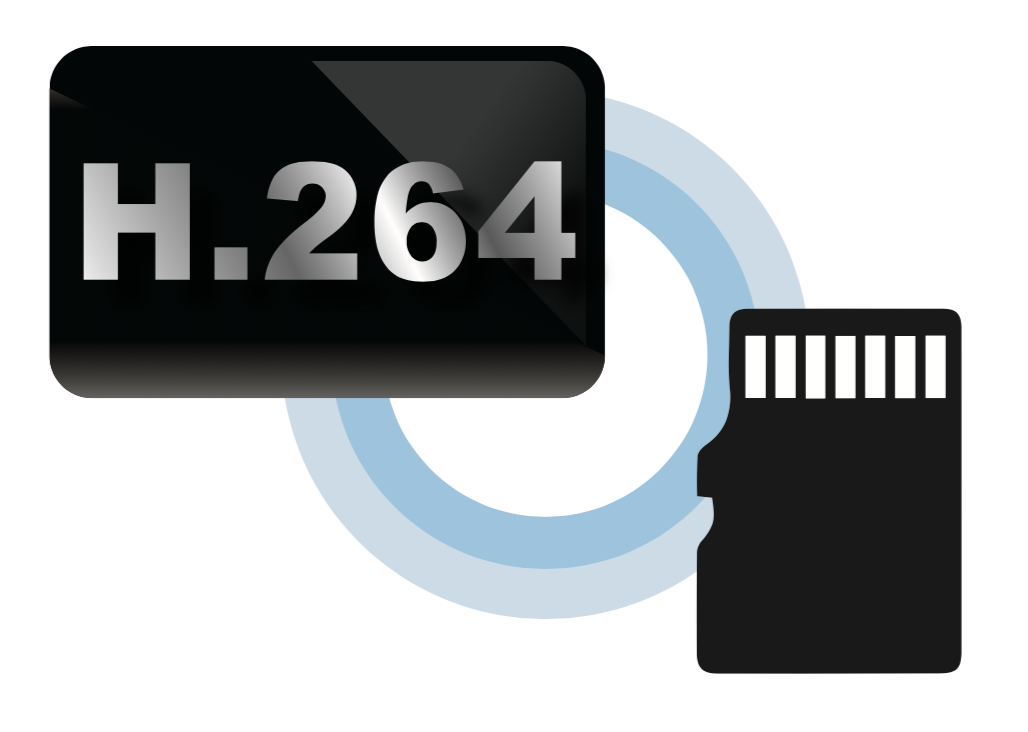 The switcher allows you to both broadcast streaming content in H.264 over a network via Ethernet, and record this content to an SD card, the connector of which is provided on the front of the switcher.
The switcher allows you to both broadcast streaming content in H.264 over a network via Ethernet, and record this content to an SD card, the connector of which is provided on the front of the switcher.
 A feature of this mixer is the ability to shoot, process and broadcast video content not only in the usual landscape mode, but also in portrait mode, which is popular for shooting or viewing from smartphones.
A feature of this mixer is the ability to shoot, process and broadcast video content not only in the usual landscape mode, but also in portrait mode, which is popular for shooting or viewing from smartphones.
Accordingly, the second input on the mixer can be used to capture presentation material from a PC. Two microphone inputs with additional RCA interface input and the same output. And the result is a rather interesting video mixer, which on the one hand can cut 4 scenes from one stream, the second input with a lower resolution can be used for presentation content, capture sound from two microphones and at the same time support simultaneous streaming. All this together creates a compact device.
The final mixer that has been on the market for quite some time, but is not as popular as the previous ones. Developed by a famous Japanese company founded in 1946, it introduced the Sony MXC-500 mixer at the end of 2016 .
 |
|
|---|---|
| Model | MXC-500 |
| Short description | Mixer with the ability to work with various cameras, use as a 5-channel audio mixer. Stream, record to SD cards. And all this in a convenient one-stop-shop. |
| Video inputs | 4x SDI;
2x HDMI (up to 19201080i / p); |
| Video outputs | 1x SDI (PGM);
2x HDMI (PGM, multiview) (1920x1080i / p); |
| HDCP | Not supported |
| Audio inputs | De-embedding from SDI, HDMI;
2x XLR / TRS; |
| Audio outputs | SDI, HDMI embedding;
2x LINE L and R; |
| SD card recording | Present |
| RRP cost (end of 2020) | 220'000 rub |
Plus built-in external SD card recording, replacing a separate recorder and simultaneous H.264 streaming. And all this in one package - a compact mini-mixer.
Conclusion
Each manufacturer strives to keep up with the times, meeting the requirements of today. Namely, to implement a compact "all-in-one" device, with the ability to switch input sources, microphones by ordinary users, as well as provide streaming to most modern platforms to increase their audience. At the same time, each device has, although similar, but still different functions and chips. Some develop a convenient frame-changing fader, others take users in a compact size, still others use a huge touch screen, and so on. All these bells and whistles create an extended model range, which means they allow you to choose the optimal solution for each task.